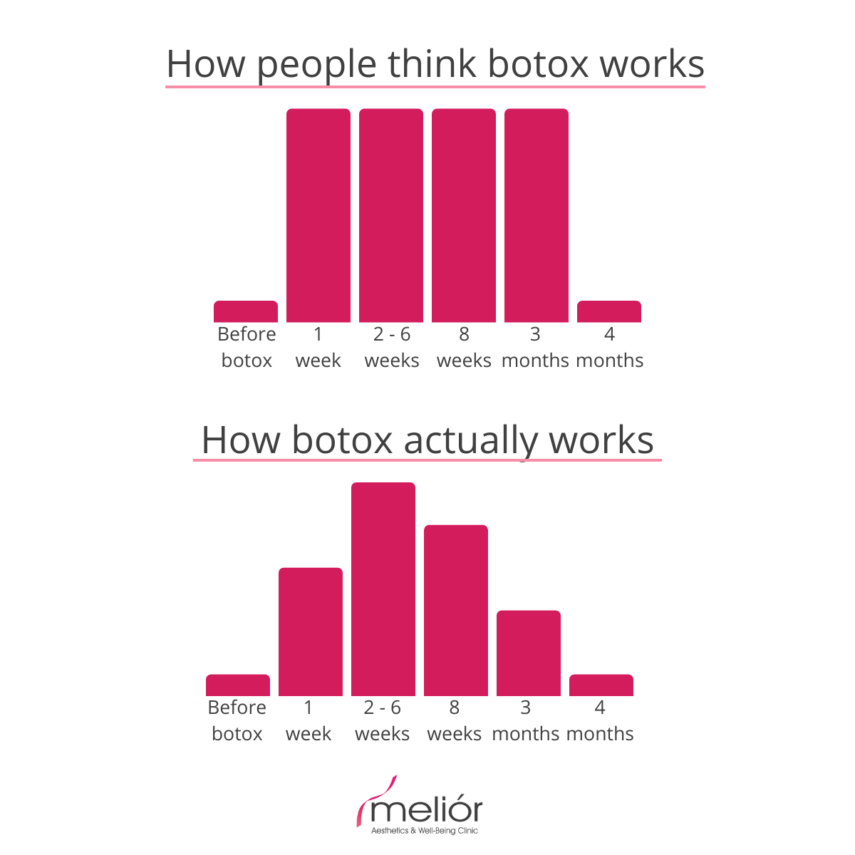We explain the importance of quality products and expert administration.
How long does botox last? Understanding how the effects of botox decrease over time.
There can be some miscomprehension about the length of time that botox is active in the body and, therefore, the duration of its effects.
Botox is an extremely effective way to reduce the appearance of lines and wrinkles. Here we summarise how it works and why, and in what timeframe, its effects decrease.
We hope that this will be helpful and reassuring to patients when planning their treatment.

How does botox work?
Natural muscle activity which causes repetitive facial movement and expression is one of the main reasons why our faces can become lined. Some lines and wrinkles are particularly associated with facial expression, such as frown or glabella lines, ‘bunny’ lines and nasolabial folds.
Botox temporarily relaxes muscles by blocking the nerve signals which would otherwise cause them to contract.
By reducing the muscle activity that would normally cause wrinkles, botox reduces the appearance of these lines and, when used early enough, can stop them from forming.
Experts in facial anatomy and aesthetics, such as the practitioners at Melior Clinics, use their understanding of how facial muscles move and work to create extremely natural results with botox.
How long does botox last?
On average, the duration of botox in the body is around three to four months.
The length of time botox continues to work in the body differs from patient to patient. Factors such as metabolism and muscularity can influence the longevity of botox in each individual.
It’s important that botox is administered carefully and correctly. Muscle size and strength, as well as depth of wrinkles, will be factors in how your practitioner assesses the appropriate amount of botox and where it is placed. A decrease in the efficacy of botox is a natural part of the process.
Why does botox decrease?
The natural process of the body constantly creating new neurotransmitters means that the effect of botox blocking nerve signals gradually reduces over time.
Eventually the muscles are no longer inhibited, so further botox treatment is needed to re-establish the effect.
What factors influence this decrease?
Metabolism
Depending on the chemistry of the individual patient, botox will be processed in a slightly different timeframe, the treatment typically lasts between three and four months.
Extent of lines and wrinkles
Patients with finer lines may find that the effects of their botox treatment lasts longer than 4 months. Whereas patients with deeper lines and larger muscle tissue may experience a more rapid decrease between treatments.
Area being treated
In some areas of the face, botox treatment can have more longevity. For example, effects in the muscles on the forehead and between the eyebrows can be slower to decrease.
Facial expression
Patients with naturally more animated facial expression and muscle activity may find a more rapid decrease in the effects of botox.
How often is botox treatment needed?
The effects of botox can build over time, as your muscles become more conditioned to the botulinum toxin. Therefore, it’s important to be aware that the first time you have botox, results may not have as much longevity compared to when you are several treatments down the line.
After the first treatment, a second appointment may be recommended for two or three months later.
After several sessions, the skin has more time to ‘fill in’ the lines and wrinkles through natural collagen production, therefore treatment will last longer and follow up sessions will become less frequent.
On average treatments are three to four months apart.
Talk to us about botox treatment
We offer a free initial consultation where we’ll discuss the most appropriate treatment for your desired outcome. If you’re happy, you can go ahead with your treatment immediately.
You can have your treatment at one of our Save Face accredited clinics – book online or call us.
Have a look at our botox before and after pictures.



